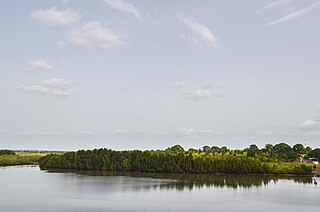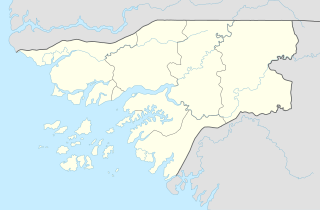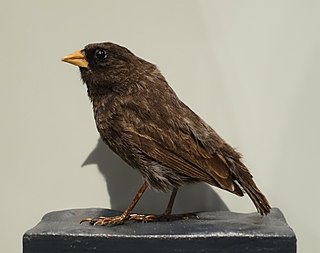
Oio is a region in Guinea-Bissau. Its capital is Farim. Other major cities and towns include Nhacra, Mansôa, Bissorã and Cumeré. The region borders Senegal to the north, the Guinea-Bissau regions of Bafatá, Bissau and Biombo to the east, the Rio Geba/Guinea-Bissau region of Quinara to the south and the Guinea-Bissau region of Cacheu to the west. There has not been any local administration since the civil war of 1998-99 and all the social services are done by organs of civil society and other government agencies. It is a coastal region covered with Mangrove swamps, rain forest and tangled forest and receives an annual rainfall of more than 1,000 mm (39 in), while the inland has Savannah woodlands.

Mansôa is a town located in the Oio Region of Guinea-Bissau. Population 7,376. The Sua language is spoken in Mansôa.

The Pacific-slope flycatcher is a small insectivorous bird of the family Tyrannidae. It is native to coastal regions of western North America, including the Pacific Ocean and the southern Gulf of California, as far north as British Columbia and southern Alaska, but is replaced in the inland regions by the Cordilleran flycatcher. These two species were classified as a single species, commonly called the western flycatcher, by the American Ornithologists’ Union until 1989. In winter, both species migrate south to Mexico, where they are virtually indistinguishable from one another.

There are 39 sectors of Guinea-Bissau which subdivide the regions. The sectors are further subdivided into smaller groups called sections ; which are further subdivided into populated places. Here are the following listed below, by region:
Clube de Futebol Os Balantas is a Guinea-Bissauan football club based in Mansôa. They play in the top division in Guinean football, the Campeonato Nacional da Guiné-Bissau. The club is named after the Balanta people, the club location where the people inhabit. Mansoa is the main city of the Balantas in Guinea-Bissau. It is being the most popular club of the Oio Region.

The Zacatecan deer mouse or southern rock mouse is a species of rodent in the family Cricetidae. It is found only in Mexico, and is not considered endangered.

The sharp-beaked ground finch is a species of bird in the Darwin's finch group of the tanager family Thraupidae. It is classified as a least-concern species by the International Union for Conservation of Nature and it is native to the Galápagos Islands in Ecuador. It has a mass of around 20 grams (0.71 oz) and the males have black plumage, while females have streaked brown plumage. This finch was described by Richard Bowdler Sharpe in 1888.

Technomyrmex albipes, commonly known as the white-footed ant, is a species of ant first described in 1861 from Sulawesi, Indonesia by the British entomologist Frederick Smith. Invasive pest ants in Florida, previously identified as T. albipes, have now been separated as Technomyrmex difficilis, both forming part of a species complex with a worldwide distribution.

The Guinean mangroves are a coastal ecoregion of mangrove swamps in rivers and estuaries near the ocean of West Africa from Senegal to Sierra Leone.
Sua, also known as Mansoanka or Kunante, is a divergent Niger–Congo language spoken in the Mansôa area of Guinea-Bissau.

Mansoa is a genus of tropical, flowering vines in the family Bignoniaceae.

Mansoa verrucifera is a species of liana in the family Bignoniaceae. It is native to Mexico, Guyana, and Venezuela. M. verrucifera bears long, narrow fruit, and has trifoliolate leaves that grow oppositely.

Acacia difficilis is a tree belonging to the genus Acacia and the subgenus Juliflorae that is endemic to tropical parts of northern Australia.
Faxonius maletae, sometimes called the Kisatchie painted crayfish or Kisatchie painted crawfish, is a species of crawdad in the Cambaridae family. The specific epithet maletae is in honor of the discoverer's wife, author Maleta M. Walls, who helped collect many of the original specimens. It was originally described as a subspecies of Orconectes difficilis, but later elevated to full species status. The common name refers to the Kisatchie National Forest, near where the original specimens were found in Bayou Santabarb.
The 2017–18 Campeonato Nacional da Guiné-Bissau season is the 41st edition of the top level of football competition in Guinea-Bissau. It began on 25 November 2017 and ended on 18 June 2018.
Miastor is a genus of gall midges and wood midges in the family Cecidomyiidae. There are about seven described species in Miastor.
The 2018–19 Campeonato Nacional da Guiné-Bissau is the 42nd season of the Campeonato Nacional da Guiné-Bissau, the top-tier football league in Guinea-Bissau. The season started on 22 December 2018.
Sphaerodactylus difficilis, also known as the Hispaniolan eyespot sphaero or difficult least gecko, is a species of lizard in the family Sphaerodactylidae. It is endemic to Hispaniola.










